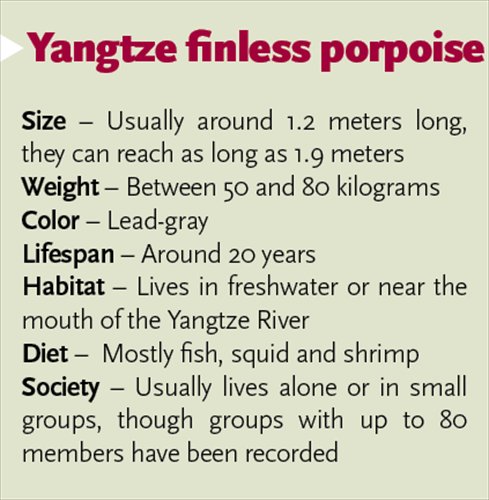
Porpoise haven
The Swan Island nature reserve, in Shishou, Hubei, received five migrant finless porpoises in 1990. Researchers wouldn't or couldn't directly move the baiji there, so they first moved porpoises there as an experiment.
The first-generation immigrants quickly adapted to their new home, and their population has grown steadily. In most of the years since then, three to six porpoises have been born there, and the number of births is increasing year-on-year. This year, nine finless porpoises are expected to be born in Swan Island, pushing the total population to 70. Swan Island is the only place where the porpoises' population is increasing.
The 21 kilometers of old Yangtze riverbed around Swan Island are particularly suited to be a new home for these endangered animals. As part of the old course of the Yangtze, it had remained largely pristine, in contrast with the bustling traffic and industrialization along the Yangtze. However, the animals still face challenges here. In 2008, southern China was hit by an unusually harsh winter, and Swan Island's lake was covered in 30 centimeters of ice. In order to surface to breathe, the porpoises had to headbutt their way through the ice. Six were later found dead from head wounds. No one expected that a lake in the usually warm south would freeze.
Moreover, the Economic Information Daily reported that the area has also been faced with increasing environmental pressure caused by economic development today.
Zhang Zhenhua, deputy director of the reserve, said the water quality around Swan Island is now even worse than that in the Yangtze. Although farming is forbidden in the reserve's core area, some villagers simply ignore the ban, and there is no punishment to deter them. The nature reserve, which was planned to be about 70,000 mu (4,666 hectares), has shrunk to around 30,000 mu due to the encroachment of farming.
According to Zhang, in 2014 construction started on a food processing factory in the reserve's protected zone. The city government refused to act, and the nature reserve had to report the problem to the provincial government before the factory was dismantled.
"We can't put all the eggs in one basket," Wang said. As the porpoise population expands, inbreeding will eventually harm the community.
In 2012, the Ministry of Agriculture held a symposium on porpoise protection. During the meeting, experts and fishery administrators agreed that given that conditions in the Yangtze will not radically improve in the short term, it is necessary to establish new reserves for finless porpoises. After the meeting, the ministry entrusted CAS to draft a Yangtze Finless Porpoise Salvation Plan, which focused efforts on finding reserves. Wang Ding said they hope to establish five to 10 natural reserves in the next 10 years on the middle and lower reaches of the Yangtze, and porpoises will be rotated among the preserves to ensure genetic diversity.
Three years ago, the World Wildlife Fund (WWF) proposed establishing another reserve for finless porpoises in Hewangmiao, Hubei. After surveying the site, scientists found the environment there had been well preserved. Local people fish in the lake, which is regularly filled by the Yangtze and has no industrial pollution. It could well accommodate 100 porpoises if maintained properly.
Under the CAS plan, eight young and strong porpoises were selected, aged between 2 and 5, and were relocated to Hewangmiao and Swan Island.
Resource collapse
While concrete moves are being made to save the finless porpoise, the reality of environmental degradation on the Yangtze is larger than any one species.
The Yangtze, the world's third longest river, used to have an abundant variety of wildlife. There are more than 300 species of fish in the river, about half of which are only found in the Yangtze. However, one third of these species are now threatened with extinction.
In 2013, the WWF and the Ministry of Agriculture jointly published a report warning of the collapse of fishing resources on the upper reaches and the disappearance of half of the species unique to the river. Over-exploitation of hydropower and illegal fishing are two of the direct causes of the damage. Another research project found that the number of "four major Chinese carps" has decreased from 30 billion in the 1950s to no more than 100 million.
China is dedicated to the development of the Yangtze River Economic Belt, but the sheer density of human activities has made it a river of death for its non-human inhabitants.
As of today, eight natural reserves for porpoises at different administrative levels have been established along the Yangtze and many of the lakes connected to it. However 2012 figures showed that the number of porpoises in river preserves was still decreasing.
But this relocation program is not intended as a farewell to the Yangtze. "We hope one day when the ecosystem recovers, they will return to the Yangtze River, to their own home," said Wang.


















































